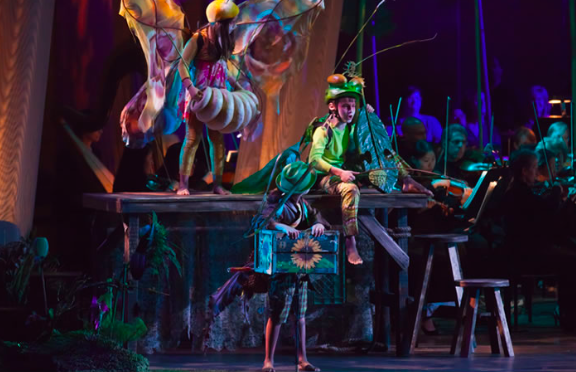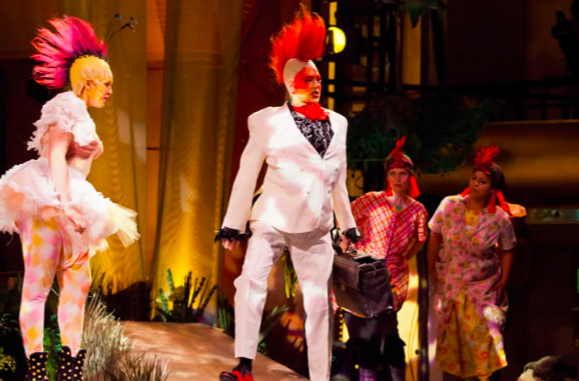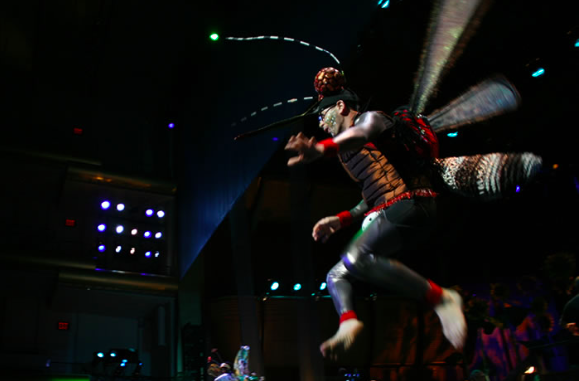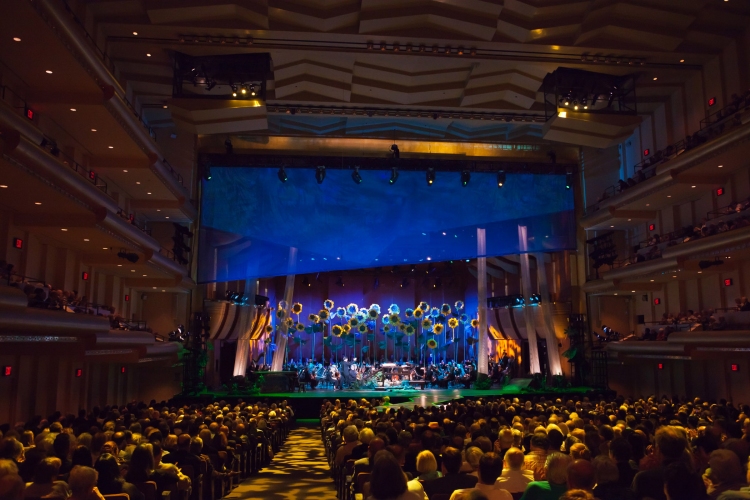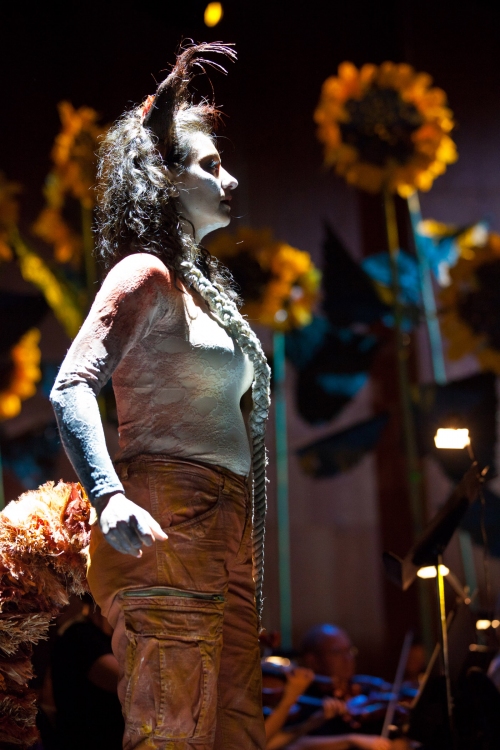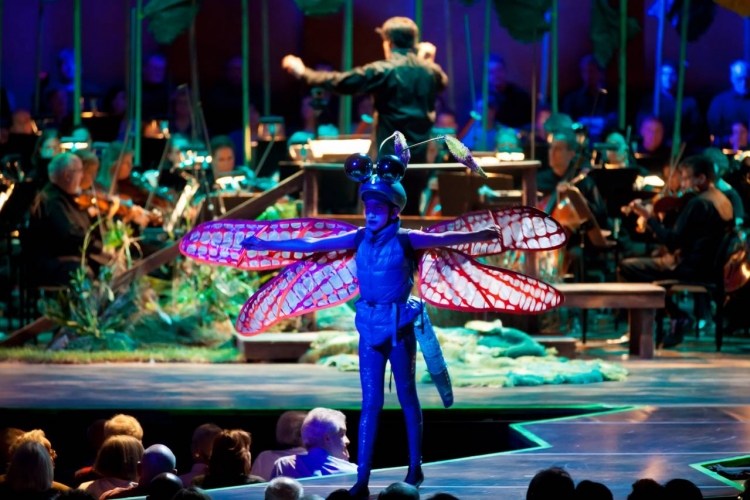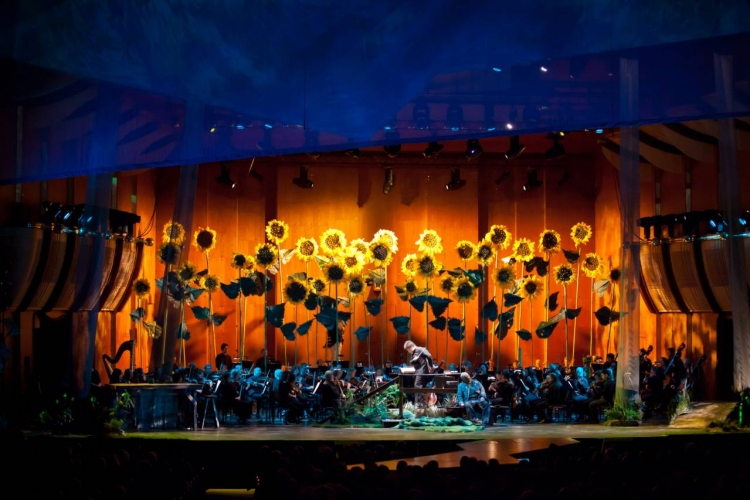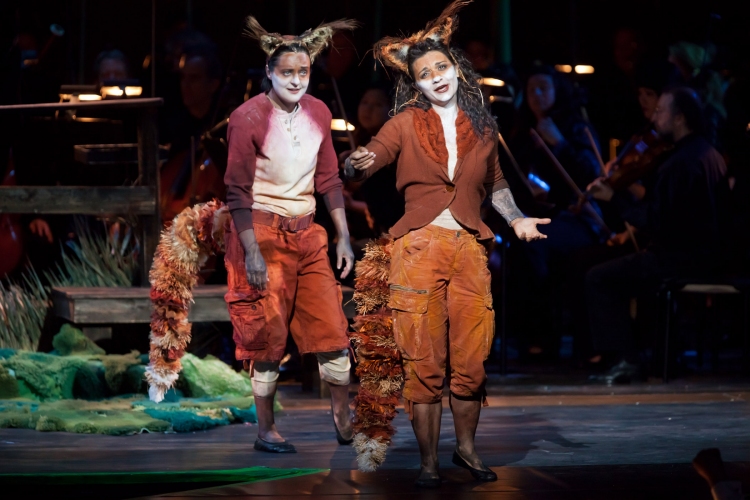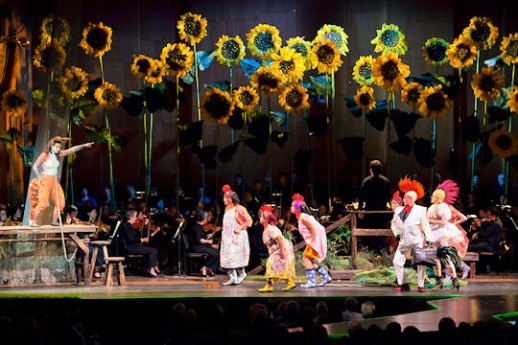For the New York Philharmonic, Alan Gilbert Music Director. Produced in collaboration with Giants are Small, Eduoard Getaz, Producer (2011)
Music by Leoš Janáček
Directed by Doug Fitch
Scenery by Doug Fitch and GW Mercier
Costumes by Doug Fitch
Lighting by Clifton Taylor
Press
The New York Times
An Impish Creature That Won’t Be Fenced In
By ANTHONY TOMMASINI JUNE 23, 2011
The New York Philharmonic might want to keep some of the tall sunflowers that loom from the back of the stage at Avery Fisher Hall in its enchanting production of Janacek’s anthropomorphic opera, “The Cunning Little Vixen,” which opened on Wednesday night. The hall is rather drab, and the fairy-tale flowers would dress up the place. Also, on nights when Philharmonic concerts are less than inspired, a remnant of Doug Fitch’s lovely Janacek production would remind listeners of one of Alan Gilbert’s boldest artistic ideas.
The highlight of last season, Mr. Gilbert’s first as music director, was the Philharmonic’s presentation of Ligeti’s apocalyptic comic opera “Le Grand Macabre,” also directed by Mr. Fitch. And it really was a staged production, ingeniously conceived, involving puppets, projections, live videos and wild costumes. The project was driven by Mr. Gilbert’s convictions that American orchestras must reinvent themselves and that the Philharmonic could turn Avery Fisher Hall into a suitable site for a major 20th-century opera in its first New York staging.
Mr. Gilbert and Mr. Fitch have another success with this “Cunning Little Vixen,” featuring a large, winning cast of singers; the New York Choral Artists; and a dozen sweet-voiced members of the Metropolitan Opera Children’s Chorus, who crawled, hopped and scampered around the extended stage, dressed as a frog, a moth, a rabbit, a beetle, a mosquito, a butterfly and other creatures.
On the surface, “Vixen” might seem a safer choice than “Le Grand Macabre,” a bleakly comic, musically thorny work from the late 1970s that received its first American staging only in 2004, at the San Francisco Opera. “Vixen” is familiar to those who saw New York City Opera’s lovely production, last presented in 1991, back in what increasingly looks like the bygone glory days of that struggling company.
Yet “Vixen” is a more elusive and complex work than its story might suggest: a fable about an impish vixen who is captured young by a forester, laments her fate as a pet, makes an escape, mates with a fox, raises a brood of offspring and is killed by a poultry dealer. The human characters are troubled souls, especially a drunken priest who has never lived down the false accusation that he seduced a woman in his youth, and a mopey schoolmaster who loves a villager from afar.
What’s more, the glowing, urgent performance that Mr. Gilbert drew from the Philharmonic brought out all of the music’s modernist touches, with whole-tone scales that recall late Debussy; modal melodic writing that evokes Moravian folk music; and the extensive use of repetitive figures that lend the score a ritualistic strangeness. As performed here, “The Cunning Little Vixen,” completed in 1923, seems not that far removed from the grim Janacek opera that preceded it, “Katya Kabanova,” and the eerily mysterious one that followed it, “The Makropulos Case.”
Janacek did not want this fable, set in Moravia around 1920 in a forest, a farmyard and an inn, to seem cutesy. The music uncannily blends restless animation with somber contemplativeness, conveying that the natural world, though baffling and brutal, is alive with lust, yearning, ecstasy and danger.
Mr. Fitch also did not want his “Vixen,” created with his production company Giants Are Small, to come off as cutesy. The wondrous costumes he designed for the animals use everyday objects, which lend a wry, unsentimental touch to the staging. Various grasshoppers and beetles wear painted bicycle helmets; the frogs leap about in green rubber flippers; the mosquito that feasts on the napping forester has a swim cap adorned with what look like big blue Christmas tree bulbs. The hens appear as animal housewives in flower-patterned dresses with inflated red rubber gloves atop their heads. You wonder if Mr. Fitch comes up with such ideas during random shopping trips.
This is a much simpler production than the one Mr. Fitch created for the Ligeti opera. There are no video elements, just singers and dancers on the stage, which extends into the auditorium, including a jagged pathway that takes cast members well into the orchestra section. Besides those sunflowers, the sets by Mr. Fitch and G. W. Mercier are just painted cloth drapes, a few see-through-fabric tree trunks, a low shack (where a badger lives until the vixen evicts him) and a platform for Mr. Gilbert that looks like a mossy hill in a marsh.
The cast, singing Norman Tucker’s English translation of Janacek’s own Czech libretto, is excellent. The soprano Isabel Bayrakdarian looked like a mischievous scamp in her vixen costume and sang with dark, rich sound and impetuous spirit. Her diction was sometimes blurry (though there were projected titles for the audience). But there was no problem making out the words of the robust baritone Alan Opie as the Forester, who brought out the character’s internal conflicts.
The mezzo-soprano Marie Lenormand is wonderful as the ardent Fox who weds the Vixen in one of the most disarming love scenes in all of opera. The tenor Keith Jameson, singing with impeccable diction, captures the pining schoolmaster’s haplessness. The sturdy bass Wilber Pauley, first as the Badger, then as the self-doubting Parson, is also strong. The baritone Joshua Bloom brings chilling power to the implacable poultry dealer. And the child soprano Noah Sadik, playing the young vixen, sings tenderly and looks understandably terrified when the forester hoists him over a shoulder, stealing the vixen away.
You would think that the Philharmonic, having gone to all this expense, would have found a way to present the Janacek opera for more than a four-performance subscription week run. The lucky audience on Wednesday gave everyone involved a cheering ovation, especially Mr. Gilbert and the orchestra, for bringing such an imaginative opera production to the Philharmonic.
The Wall Street Journal
The Beauty of the Beasts
By HEIDI WALESON June 28, 2011
New York
In May 2010, the New York Philharmonic scored a coup with a riotously staged production of György Ligeti's "Le Grand Macabre," an anarchic look at the end of the world. Like that opera, this year's production of Leoš Janáček's "The Cunning Little Vixen" (1924) is being presented by director Doug Fitch and the production company Giants Are Small. But "Vixen" is a very different modern work, a celebration of lust, life and the cycles of nature that was last seen in New York in 1998, in the charming 1981 Frank Corsaro-Maurice Sendak production at the New York City Opera. Death arrives, but it is part of the natural order. Janáček's lush and gorgeous score, and the poignant parallels drawn between the lives of the human and animal characters, make this a rewarding piece of theater, worthy of being staged far more often than it is.
Janáček based his opera on a comic strip, "The Adventures of Vixen Sharp-ears," adapting the libretto himself. An aging Forester captures the baby Vixen and brings her home, but true to her natural, wild instincts, she wreaks havoc on the household and escapes to the woods, where she finds a mate, has so many children that she loses count, and is killed by a poacher. The Vixen's vigorous coming of age is contrasted with the decline of the Forester and his two drinking buddies, the Schoolmaster and the Parson, who pine for their lost youth and sadly watch the local beauty marry a younger man.
Mr. Fitch took a more realistic and less technology-based approach to this anthropomorphic fable than he did for the Ligeti. Enormous sunflowers sprouted from the stage to tower over the Philharmonic players; vines twined around the onstage lighting equipment; a wooden inn table at stage right doubled as the Vixen's den; and a catwalk stretched out into the audience, extending the playing area on the stage in front of the orchestra. (G.W. Mercier and Mr. Fitch did the scenic design.) Clifton Taylor's lighting suggested the warmth and darkness of the forest.
Mr. Fitch's eye-popping animal costumes playfully merged elements of human garb with animal features: A hedgehog's spines sprouted from a zippered sweatshirt, the Vixen's cubs looked like scruffy urchins with ears and tails. Costumes for the domestic animals had even more elements of human clothing: The Forester's hens sported house dresses and colorful rain boots. Cookie Jordan did the elaborate makeup. Most of the forest creatures other than the Vixen and her mate were perkily played by members of the Metropolitan Opera Children's Chorus, and Karole Armitage choreographed their witty animal gestures and movements. As the Dragonfly, Neel Najarajan was especially graceful.
But both the physical and musical direction missed some of the opera's subtleties. Conductor Alan Gilbert's approach was large-scale and Wagnerian, with an orchestral sound that stressed power rather than delicacy and often covered the voices, making it difficult to distinguish the text (an English translation by Norman Tucker) without relying on the supertitles. The fine baritone Alan Opie gave a performance that emphasized the Forester's anger at the Vixen and his own mortality. The touching penultimate scene—in which the Schoolmaster (the bracing tenor Keith Jameson) quietly weeps over his hopeless love for the town beauty Terynka, and the innkeeper's wife (Tami Petty) tells the Forester that the Parson, who has moved away, is homesick—was played for laughs. It missed the deep sadness that sets up the joyous finale in the forest, when the Forester at last understands the beauty as well as the ferocity of the natural life cycle. The performance felt rather muscular and heavy, a contradiction to the wild, feminine energy of the opera's title character.
As the Vixen, soprano Isabel Bayrakdarian displayed plenty of that ebullient spirit, however. Full-voiced, agile and impudently funny, she bounded around the stage, blithely tricking the Forester's vain and stupid chickens, appropriating the old Badger's den, learning about love from the Fox, chomping on a rabbit, and howling defiance at Harašta, who shot her.
Mezzo Marie Lenormand was sweetly swaggering as the Fox, who woos and wins the Vixen; baritone Joshua Bloom was pure testosterone as Harašta; and mezzo Melissa Parks was imposing as the Forester's impatient wife and the Owl (for which she wore a cagelike garment flecked with feathers). Bass Wilbur Pauley growled with impotent menace as the Parson and the Badger. The chicken contingent was hilarious, led by Emalie Savoy, wearing a man's suit with a puffed up front as the Cock, and Devon Guthrie in burlesque-inspired lingerie as the principal hen. Kelley O'Connor was the mournful old Dog. Dancer Emily Wagner was a seductive Terynka, the Vixen's human counterpart, her silent but physically eloquent presence driving the men mad, which, finally, is what the opera is all about. The men can shoot the women (or Vixens), and try to domesticate them, but the women still have the upper hand.

